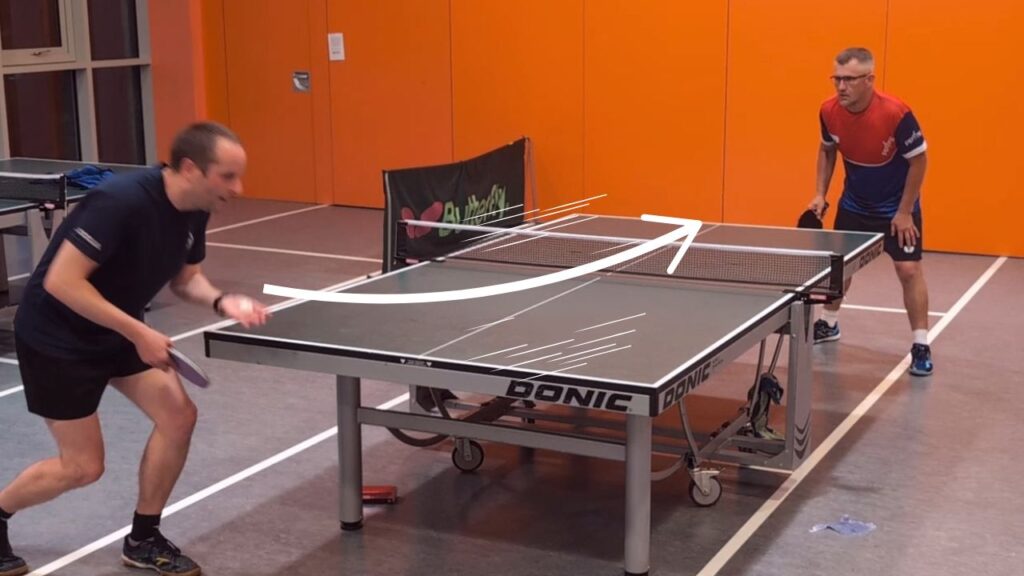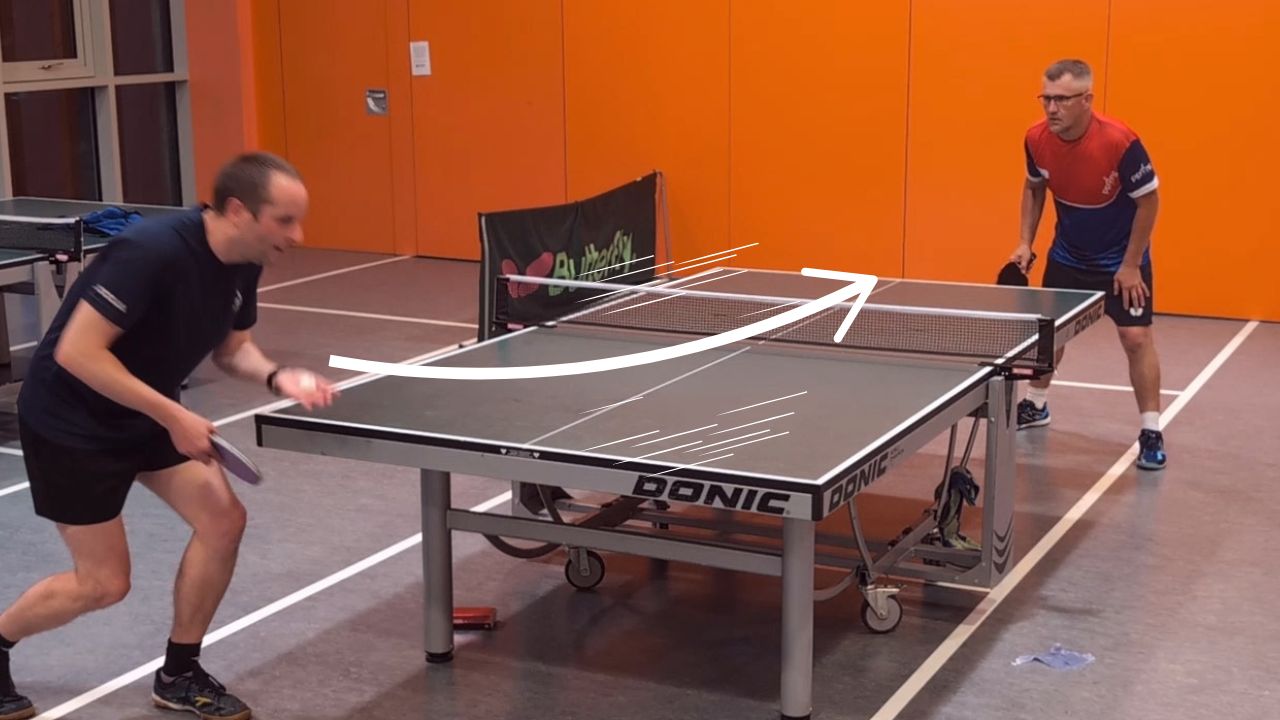
At local league level players use a lot of long serves. These are serves which land very deep on your side of the table. These serves are usually topspin or sidespin, but can be backspin too.
The length and speed of these serves can make them tricky to return. If your opponent senses you are struggling, he might serve long and fast again and again.
What’s the best way of returning these long serves? There are some common errors players make, but also some very simple adjustments. Follow the tips in this article and you’ll find it much easier.
A quick story
A few years ago we had a French player at our club called Ronald. He was a top division player and much stronger than me. He had a serve I could never return. It was a sidespin/topspin serve, which was very fast and landed very deep, aimed towards the middle of the table.
When we played practice matches, he would use this serve a couple of times every game. And I’d miss every single time. The serve was fast, so I would try to return fast. I’d swing aggressively and try to blast the ball back. Fight fire with fire! But I would always hit the ball long or miss the ball entirely.
This went on for about a year. It was so frustrating. I just couldn’t return this damn serve. Having messed up so many times, I kind of gave up. The next time I played Ronald and he did this serve, I didn’t even try. What was the point? He did his long serve, I just stuck my bat in the way half-heartedly. And guess what? The ball went in! Ronald was so surprised, he messed up his next shot. I won the point.
This was my light bulb moment. Aha! I think I’ve worked out how to return this serve. Keep it simple, stupid. From this point on I started to find it easier to return long serves. Even now, it can still be challenging and I don’t always get it right. But there are a few things I have changed which make it much easier.
Here’s some tips which may work for you too…
Tip 1 – Give yourself some space
Some players struggle with long, fast serves because they are standing far too close to the table. Think about it. If you are very close to the table and your opponent’s serve is very deep, you have very little space to play a shot. You are forced to hit the ball right off the bounce. You might get away with this occasionally, but most likely you’ll make an error.
Instead, take a step back when returning serves. Give yourself more space. Do this for every serve you face. Now, when the serve comes fast and long, you’ll actually have space to play a proper shot. You won’t feel as rushed. Your brain will have a bit more time to process the length, speed and spin of the serve.
If you take a step back, won’t you be vulnerable to short serves? No, not really. Short serves are slower, so you have more time to react. And it is much easier to move forward to a slow serve, compared to moving back for a long, fast serve.
So give yourself a little more space for all serves. You still want to be within touching distance of the table, but avoid getting jammed right up at the table.
Tip 2 – Shorten your stroke
When you face long, fast serves it can be tempting to fight fire with fire. This is where I went wrong when playing with Ronald. My opponent was serving aggressively, therefore I thought I MUST respond aggressively with a big fast swing. This rarely works. The result is usually an overhit return, a mis-hit or even an air shot, where you miss the ball completely.
You will have more success using a shorter stroke. Let’s say your opponent is doing a very fast and very long topspin serve. The most basic return you could do is a block. This is a very short stroke. You just get your bat in the way of the ball and make a small movement forward. You are using all the pace of the topspin serve and guiding the ball back.
If the serve was long, fast and loaded with backspin, you could return this with a short push. Again, as there is so much pace on the ball, you don’t need a long stroke to return the ball. Just a short pushing action will work.
The big benefit of shortening your stroke is that you will feel far less rushed. There is less you have to do. You don’t have to prepare a big backswing. You don’t need to make any big movements. You don’t need to fight fire with fire. And it’s much easier to make quick adjustments. If the serve goes a little wider, it’s much easier to move and play a short stroke, rather than trying to move and hit with a big swing.
Tip 3 – Don’t hit too hard
Linked to the previous tip, you really don’t need to hit the ball that hard. When players are serving long and fast, they are putting a lot of energy into the ball. To return this fast moving ball doesn’t require a lot of force. Even if you return these serves with a very controlled stroke, the ball will still go back very fast.
If you return a long, fast topspin serve with a basic block, the ball will still go back quickly. At lower levels, this may be enough to win the point. The server may not be expecting the ball to be returned and will mess up the next shot.
To return long, fast topspin serves very quickly, you only need a short, medium pace swing with hardly any power at all – think of a short counter- topspin. At lower levels, this will almost certainly be a winner. At higher levels, it has a good chance of being a winner or at least putting the server under a lot of pressure.
As mentioned before, a long, fast backspin serve can be returned with a simple push. This will get the ball back. It may not win you the point or put your opponent under huge amounts of pressure, but at least you will make the server play another shot. Another option would be to loop these serves back. I would recommend doing a loop with plenty of spin, rather than a power loop. A spinny loop will be more consistent and easier to execute when the ball is coming at you fast.
Don’t be intimidated
Long, fast serves can seem scary. But don’t be intimidated. Treat them as a challenge that you are determined to overcome. You don’t have to swing wildly, but you do need to play a short, positive stroke. Use the server’s pace and give it back to him.
If you follow these three tips – give yourself more space, shorten your stroke, play with more control – you will have much more success returning long, fast serves.
If the server gets no advantage, he may stop doing these long, fast serves entirely. If so, you have tamed the long serve beast.
Here’s a video I made a few years ago on the same theme. You will hear similar tips, but see visual demonstrations on how to return different types of long, fast serves…
More tips on returning serves
If you would like more help on returning serves, I recommend joining Tom’s TT Academy. I have a 10 lesson in-depth online course all about returning serves. The lessons include…
- Returning backspin serves
- Returning topspin serves
- Returning sidespin serves
- Reading service spin
- Learning from mistakes
- Where to stand when returning serves
- How to apply pressure on your opponent when returning serves
You will also get access to a wide range of coaching content, including
- in-depth courses
- training drills
- fitness videos
- robot training videos
- member discussions
- video analysis
- skill challenges
- coaching clinic
- and lot’s more!
You can access all this content for less than £1 per week. New content is added regularly. Join hundreds of table tennis players around the world today at www.tomsttacademy.com

